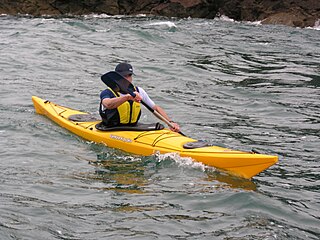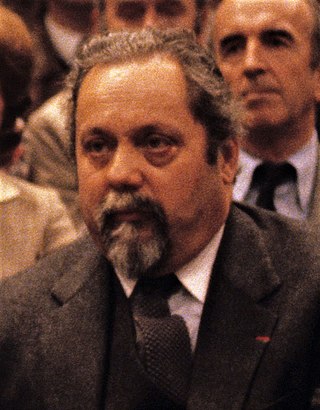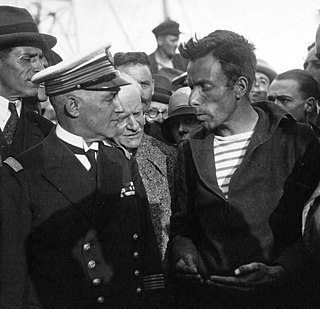Related Research Articles

Cruising by boat is an activity that involves living for extended time on a vessel while traveling from place to place for pleasure. Cruising generally refers to trips of a few days or more, and can extend to round-the-world voyages.

A sea kayak or touring kayak is a kayak developed for the sport of paddling on open waters of lakes, bays, and the ocean. Sea kayaks are seaworthy small boats with a covered deck and the ability to incorporate a spray deck. They trade off the manoeuvrability of whitewater kayaks for higher cruising speed, cargo capacity, ease of straight-line paddling, and comfort for long journeys.

The Kon-Tiki expedition was a 1947 journey by raft across the Pacific Ocean from South America to the Polynesian islands, led by Norwegian explorer and writer Thor Heyerdahl. The raft was named Kon-Tiki after the Inca god Viracocha, for whom "Kon-Tiki" was said to be an old name. Kon-Tiki is also the name of Heyerdahl's book, the Academy Award–winning 1950 documentary film chronicling his adventures, and the 2012 dramatized feature film nominated for the Academy Award for Best Foreign Language Film.

Sir Francis Charles Chichester KBE was a British businessman, pioneering aviator and solo sailor.

Alain Bombard was a French biologist, physician and politician famous for sailing in a small boat across the Atlantic Ocean without provision. He theorized that a human being could very well survive the trip across the ocean without provisions and decided to test his theory himself in order to save thousands of lives of people lost at sea.

Sir William Robert Patrick Knox-Johnston is a British sailor. In 1969, he became the first person to perform a single-handed non-stop circumnavigation of the globe. Along with Sir Peter Blake, he won the second Jules Verne Trophy, for which they were also named the ISAF Yachtsman of the Year award. In 2007, at the age of 67, he set a record as the oldest yachtsman to complete a round the world solo voyage in the Velux 5 Oceans Race.

Anthony John Francis Smith was, among other things, a writer, sailor, balloonist and former Tomorrow's World television presenter. He was perhaps best known for his bestselling work The Body, which has sold over 800,000 copies worldwide and tied in with a BBC television series, The Human Body, known in America by the name Intimate Universe: The Human Body. The series aired in 1998 and was presented by Professor Robert Winston.
Canoe sailing refers to the practice of fitting an Austronesian outrigger or Western canoe with sails.

Timothy Severin was a British explorer, historian, and writer. Severin was noted for his work in retracing the legendary journeys of historical figures. Severin was awarded both the Founder's Medal of the Royal Geographical Society and the Livingstone Medal of the Royal Scottish Geographical Society. He received the Thomas Cook Travel Book Award for his 1982 book The Sindbad Voyage.

Alain Jacques Georges Marie Gerbault was a French Sailor, writer and tennis champion, who made a circumnavigation of the world as a single-handed sailor. He eventually settled in the islands of south Pacific Ocean, where he wrote several books about the islanders' way of life. As a tennis player he was ranked the fifth on the French rankings in 1923.
Tania Aebi is an American sailor. She completed a solo circumnavigation of the globe in a 26-foot sailboat between the ages of 18 and 21, finishing it in 1987, making her the first American woman and the youngest person to sail around the world. Her record was not recognized by Guinness, because she sailed through the Panama Canal, which required assistance. She also sailed eighty miles with a friend in the South Pacific. Despite many challenges, Aebi accomplished her goal.

A sneakbox is a small boat that can be sailed, rowed, poled or sculled. It is predominantly associated with the Barnegat Bay in New Jersey, just as the canoe-like Delaware Ducker is associated with the New Jersey marshes along the Delaware River near Philadelphia.

Tilikum was a 38-foot (12 m) dugout canoe that was used in an effort to circumnavigate the globe starting in 1901. The boat was a "Nootkan" (Nuu-chah-nulth) canoe which was already old when she was obtained by captain John Voss in April 1901. The boat was built in the early 19th century as a dugout canoe made from a large red cedar log. Tilikum was purchased for $80 in silver from a native woman in a transference ceremony allegedly sealed by a bottle of rye whiskey - the name Tilikum means "friend" in Chinook jargon. Apparently, John Voss and his companion in this venture, Norman Luxton, were inspired by the voyage of Joshua Slocum, who sailed the 37-foot (11 m) sloop Spray around the world a few years earlier and wrote a best selling book about his adventures.
Hal Roth was an American sailor and author. In 1971 he was awarded the Blue Water Medal of the Cruising Club of America. He died of lung cancer.
James Wharram was a British multihull pioneer and designer of catamarans.
Ralph Frese, canoe maker and conservationist and prominent figure in the North American canoeing circles lived from 1926 until December 10, 2012. Frese lived in the Chicago area. He is known for promoting conservation and canoeing, building historic replica canoes, and starting canoeing and conservation organizations and events.

Wa are traditional sailing outrigger canoes of the Caroline Islands, Palau, and Yap. They have a single outrigger. They are similar to the sakman of the Northern Marianas.

City of Ragusa of Liverpool was a 20-foot (6 m) yawl, owned by Nikola Primorac, which twice crossed the Atlantic in the early days of 19th-century small-boat ocean-adventuring. She carried the former alternative name of Dubrovnik, the birthplace of her owner. She was originally a ship's boat of a merchantman. The 1870 east-west trip between Ireland and the United States was crewed by John Charles Buckley, a middle-aged Irishman with seagoing experience, and Primorac, a Croatian and tobacconist. The crew on the west–east return trip of 1871 were Primorac and a "lad" called Edwin Richard William Hayter from New Zealand, who had been a steward on the steamer City of Limerick of the Inman Line.
Santa Claus was an American medium clipper ship built in Boston by Donald McKay in 1854. In the course of her career, she made three voyages from the East Coast of the United States to San Francisco, California, the fastest of which was a comparatively swift 128-day passage in the winter of 1857–1858. The ship was mainly engaged in the guano trade and in trade to the Far East. In 1858, she brought Chinese immigrants to California; according to one source, she was also at one time engaged in the coolie trade.
References
- ↑ Hearst Magazines (June 1975). "Popular Mechanics". Popular Mechanics. Hearst Magazines: 130–. ISSN 0032-4558 . Retrieved 1 April 2012.
- ↑ Midwest Museums Conference (1967). Midwest museums quarterly. Midwest Museums Conference. p. 26.
- ↑ Connolly, By Colleen. "50 years ago, Francis Brenton sailed a canoe from Lake Michigan to Senegal". chicagotribune.com. Retrieved 12 December 2021.